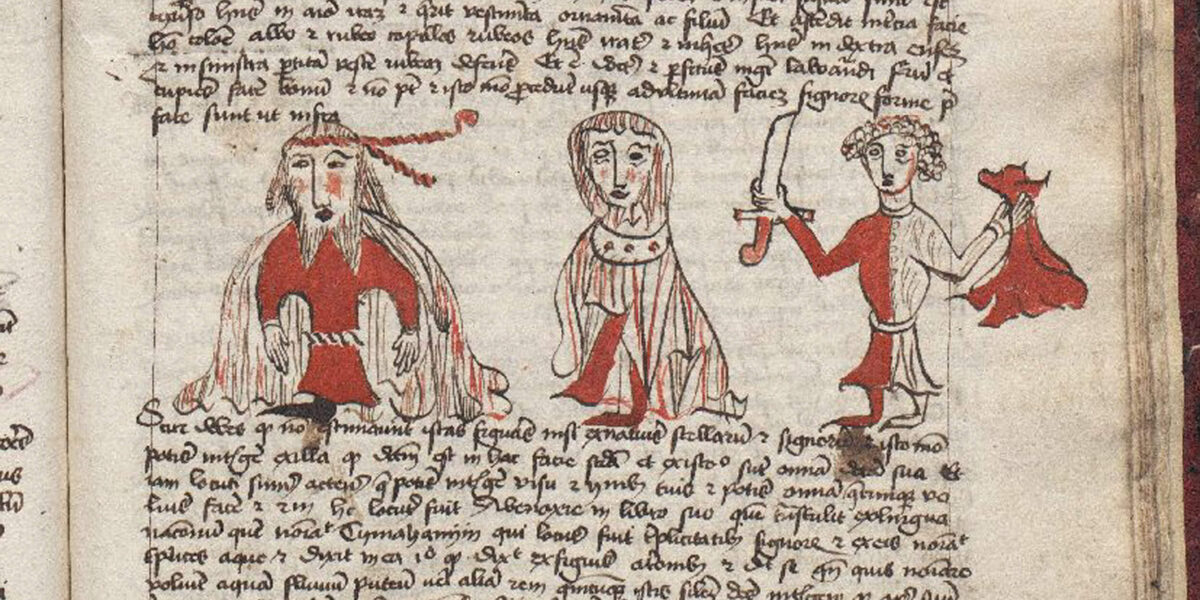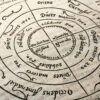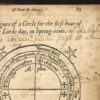A Latin Translation of the 10th/11th C text “Ghayat al-Hakim wa Ahaqq al-Natijatayn bi al-Taqdim”
by al-Qurtubi, Kraków (ca. 1460)
BJ MS 793
Updated Oct. 29, 2022
Picatrix (pronounced, “Buqratis”) is the name used today, and historically in Christian Europe, for a grimoire originally written in Arabic under the title, Ghāyat al-Ḥakīm ( غاية الحكيم ), which most scholars assume was written in the middle of the 11th century, though a supported argument for composition in the first half of the 10th century has been made. The Arabic title has been translated as “The Aim of the Sage” or “The Goal of The Wise”. The original Arabic work was translated into Spanish and then into Latin during the 13th century. According to the Latin prologue, the word “Picatrix” is the name of the author: “One wise philosopher, the noble and honored Picatrix”
According to the prologue of the Latin translation, Picatrix was translated into Spanish from the Arabic by order of Alphonso X of Castile at some time between 1256 and 1258. The Latin version was produced sometime later, based on translation of the Spanish manuscripts. Traditionally, Gayat al-Hakim has been attributed to Abu ’l-Qāsim Maslama ibn Aḥmad al-Faraḍī al-Ḥāsib al-Maj̲rīṭī al-Qurṭubī al-Andalusī (d. 1007), the Madrilenian polymath, or alternatively to one of his disciples, under the name, Maslama ibn Ahmad al-Majriti (an Andalusian mathematician). More recently however, Maribel Fierro has argued for attributing the work to al-Qurtubi, an attribution that is accepted as most plausible. The Spanish and Latin versions were the only ones known to western scholars until Wilhelm Printz discovered an Arabic version in or around 1920. (Source: Dan Attrell)
Picatrix is a manual for constructing talismans, mixing magical compounds, summoning planetary spirits, and determining astrological conditions. It is possibly the largest and most extensive handbooks of magic, a cornerstone of the grimoire tradition. The work is partitioned into four books: The work is partitioned into four books:
BOOK I
Of the heavens and the effects they cause through images made under them
Chapter 1. Of the science of understanding in what degree you are
Chapter 2. What is magic and what are its properties
Chapter 3. What are the heavens and of what are they made
Chapter 4. Of the kinds, properties, and composition of the heavens needed to make images of the Mansions of the Moon
Chapter 5. Of examples of what has been proposed, and of those things we need to make images
Chapter 6. In what degree is the microcosm, and how it is assimilated to the macrocosm
Chapter 7. In what degree anything in the world is, and of many other profound things hidden by the wise that we propose to reveal in this book
BOOK II
Of the figures of the heavens in general, and of the general motion of the sphere, and of their effects in this world
Chapter 1. How it is possible to learn this science
Chapter 2. Of the figures of the heavens and their secrets
Chapter 3. Of the works of the planets, the sun, and the moon
Chapter 4. Of the general motion of the sphere and the fixed stars
Chapter 5. Of the division of this science among peoples, and how different peoples possess different parts of it
Chapter 6. Of the power of images, and in what manner it can be had, and how images are able to receive the power of the planets, and this is the root of science and images
Chapter 7. Of how to work dialectically with these secrets of images, and what part this ought to have in this science
Chapter 8. Of the order of natural things, and how you ought to enter upon this science
Chapter 9. Of examples of figures, and the forms of imagery that call down the help of the planets
Chapter 10. Of the stones appropriate for each planet, and of the making of figures of them, and of the figures of the planets
Chapter 11. Of the figures of the faces of the signs and their effects
Chapter 12. Of the figures and degrees of the signs and their effects according to the opinion of the Hindus, and how this follows from the contemplations of this science, and in what manner spirits of the upper realms are attracted by the virtues of bodies, according to the opinion of those who have notable secrets
BOOK III
Of the properties of the planets and signs, and of their figures and forms made in their colors, and how one may speak with the spirits of the planets, and of many other magical workings
Chapter 1. Of the parts of the planets that proceed into plants, animals, minerals, and many other things, being an explanation of the virtues of the planets and of doing what you wish by their seals
Chapter 2. Of the parts of the signs in the aforesaid three existences (that is, plants, animals, and minerals) so that each sign has its properties in things, first of Aries, and then of the other signs
Chapter 3. Of the figures, colors, garments, and incenses of the planets, as well as of making their tinctures
Chapter 4. How secrets that are hidden in this science can be understood from familiar things
Chapter 5. Of the demonstration of the proper virtues in animals and noble things necessary in this science, and how the spirits of the planets are attracted by figures and incenses
Chapter 6. Of the magistery of attracting the spirits of the planets by natural things, and how it is that an image of this kind can have this power
Chapter 7. Of attracting the powers of the planets, and how it is possible to speak with them, and how this is done for each planet, including the figures, offerings, prayers, incenses, proportions, and state of the heavens necessary for each planet
Chapter 8. Of the kind of prayer prayed by Neptinus to the Sun and Saturn, and how he conversed with them and their spirits and the effects he brought about
Chapter 9. How to attract the powers of each planet and the powers of their spirits, naming them according to their parts, as well as how to accomplish this by speaking their names
Chapter 10. Of examples of confections of the spirits of the planets, and of averting harmful workings, and magic of miraculous effect, and the foods, incense, unguents, and perfumes that ought to be used to work by the spirits of the seven planets, and the proper effects of the planets, and of workings that are worked only by sight
Chapter 11. Of the effects of images in diverse things, and of altering appearances so that things seem to be other than they are, and also of how to poison by sleep, gaze, or work, and of their remedies
Chapter 12. Of the rules necessary in this science
BOOK IV
Of the properties of spirits, and of those things that are necessary to observe in this most excellent art, and how they may be summoned with images, suffumigations and other things
Chapter 1. Whence the power and strength of spirits proceeds, and what the properties, bodies, senses, intellects, and souls of spirits are, as well as what differences are among them
Chapter 2. How the vigor of the spirit of the Moon is drawn into things here below, and by which the seven planets ought to be invoked
Chapter 3. In which is said what the Chaldeans believed about the profundities or secrets of this science, and what was taught by them
Chapter 4. Of the images and reasonings that greatly help this science
Chapter 5. What are the ten sciences that are necessary to this art, and how by them this science is assisted, and what the root of the science of magic is Chapter 6. How incenses of the stars ought to be made, and certain compounds needed in this science
Chapter 7. Of those things of the art of magic that were found in the book Nabataean Agriculture that Abudaer Abemiaxie translated into Arabic from the Chaldean tongue
Chapter 8. Of images possessing miraculous virtues, that were discovered in a book that was found in the temple of Coredib and in the book of Queen Folopedia, and also concerning some corrections necessary in working with images
Translation by John Michael Greer
This particular manuscript of the Picatrix is cataloged as, Biblioteka Jagiellonska MS 793. The origin of this version is debated, and the text breaks off abruptly in the second of four parts, but it is thought to have been created by a Polish scribe in Italy, or possibly in the region around Kraków. Its creation date is estimated to be in the mid-15th century, with a binding date around 1460 (B. Lang, Unlocked Books, 2010). Lang describes it as the only illustrated copy.
I have included a 15th C copy from the the Bibliothèque nationale de France cataloged as Traité de nécromancie intitulé ‘Picatris’ (BNC Latin 10272), a 16th C copy starting on folio 182 from Die Universitäts- und Landesbibliothek Darmstadt (Hs-1410), and some manuscripts of the original Arabic text, Ghayat al-Hakim wa Ahaqq al-Natijatayn bi al-Taqdim.




